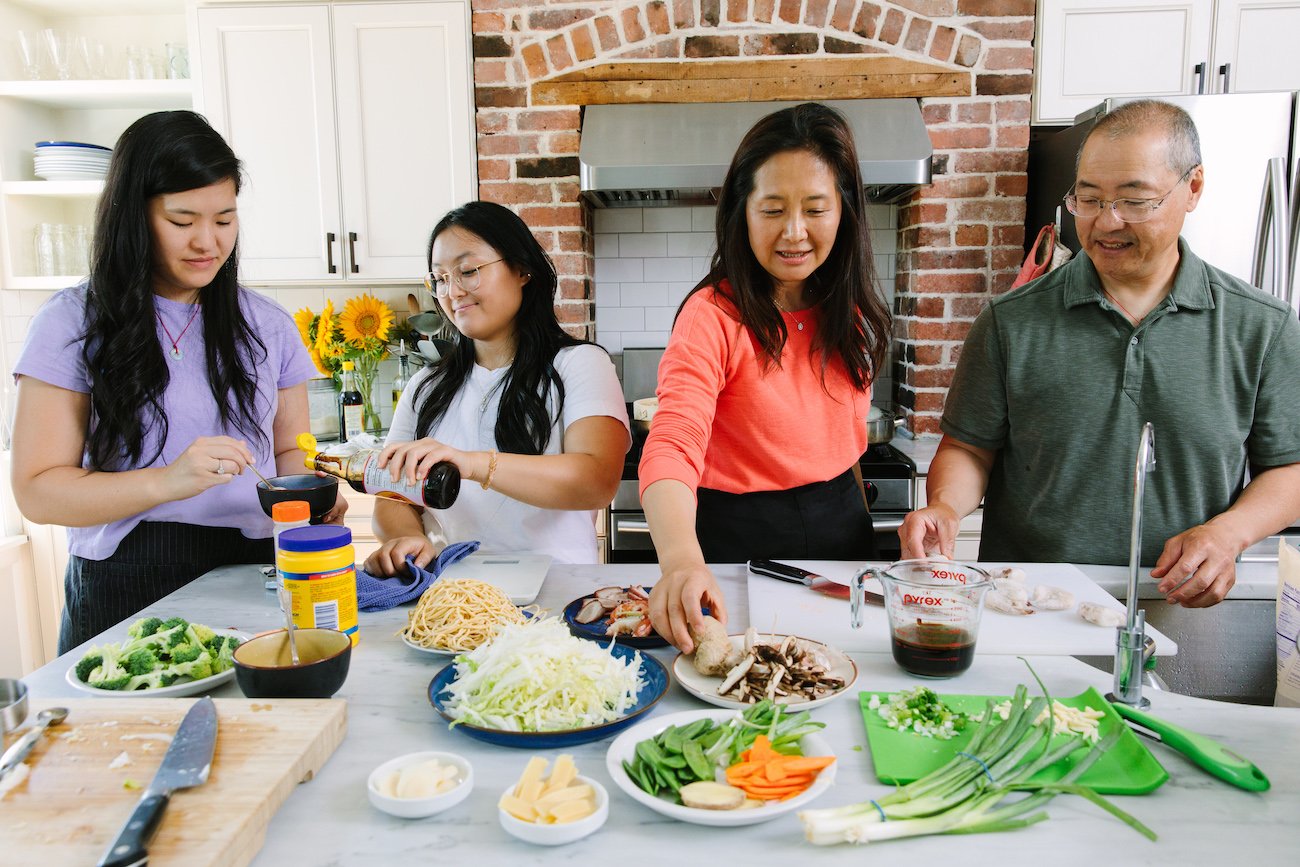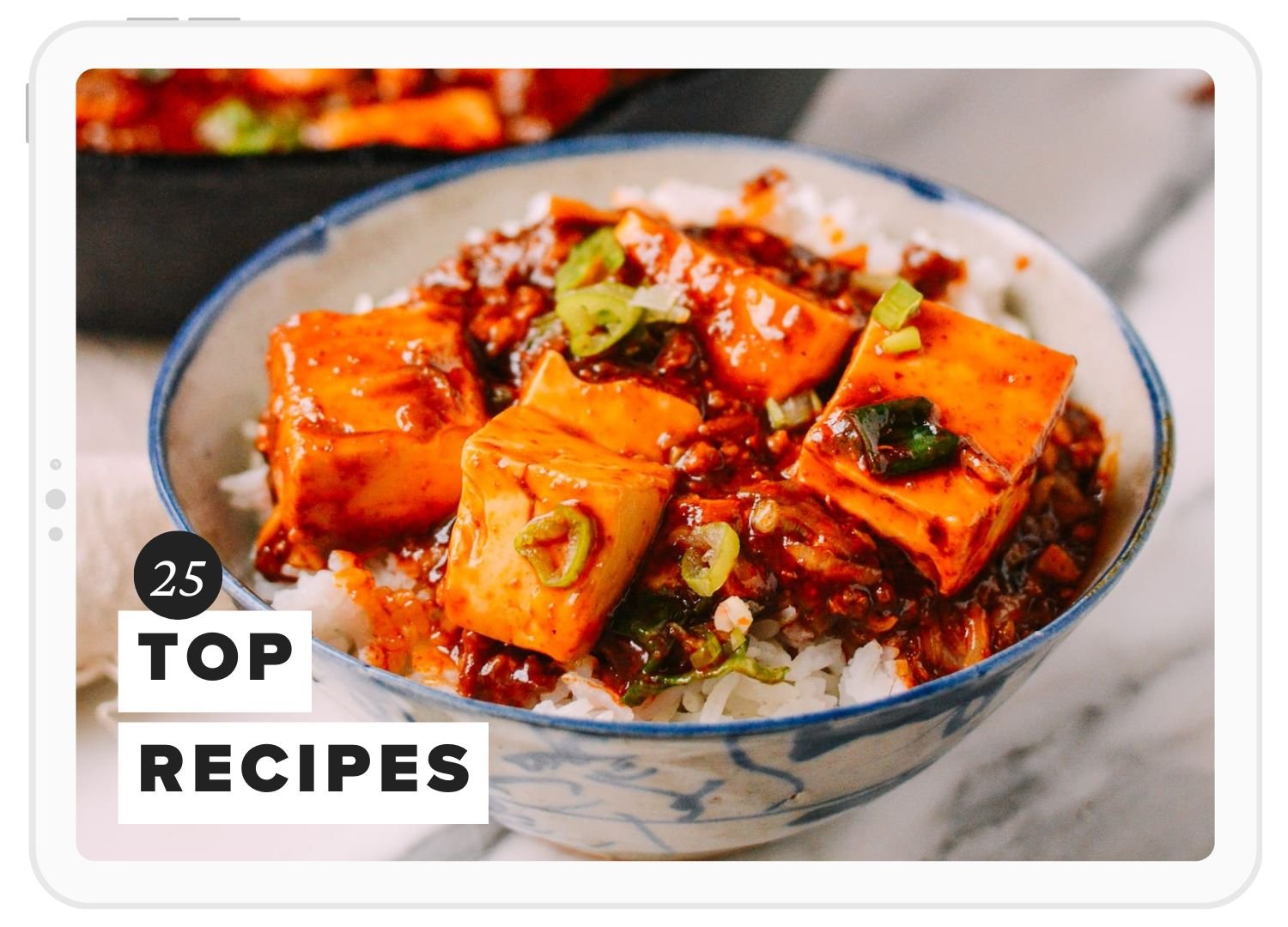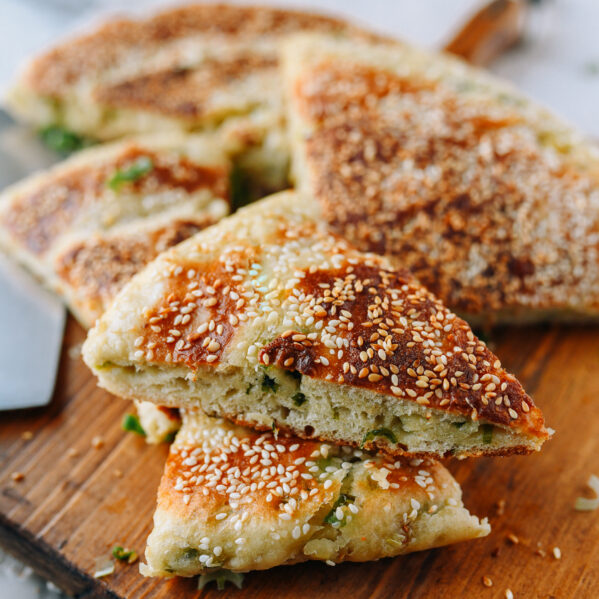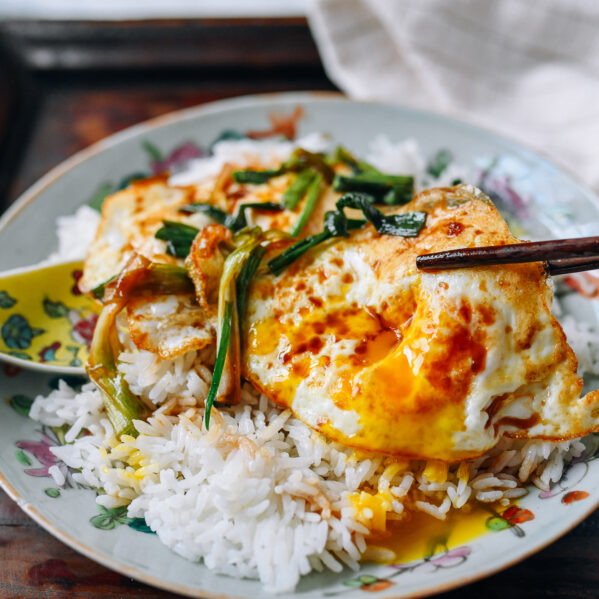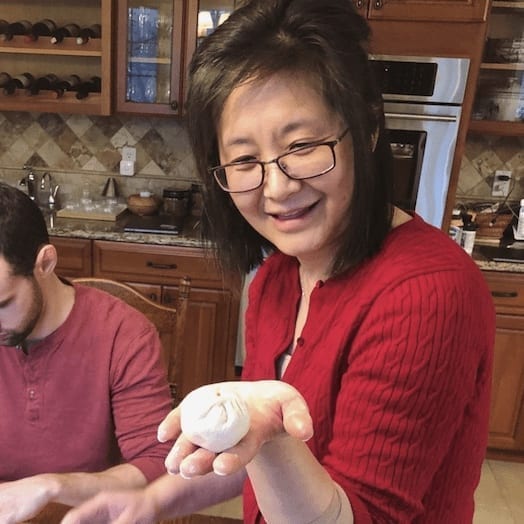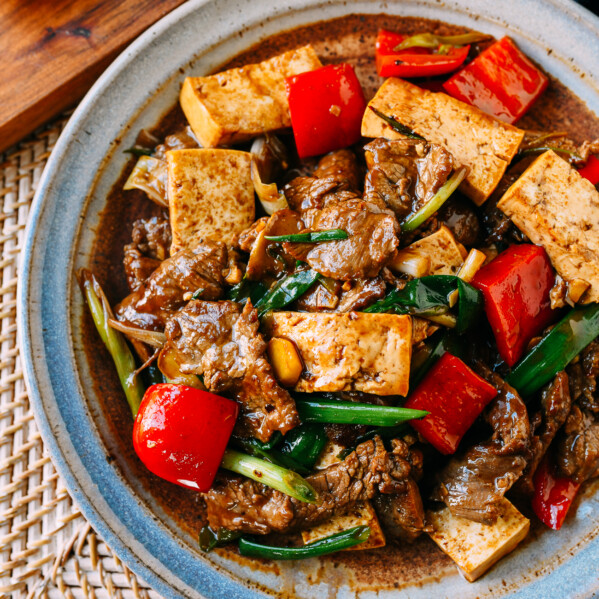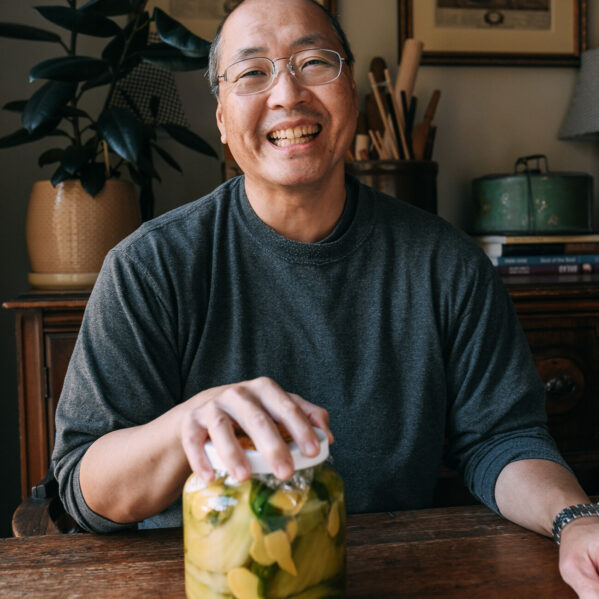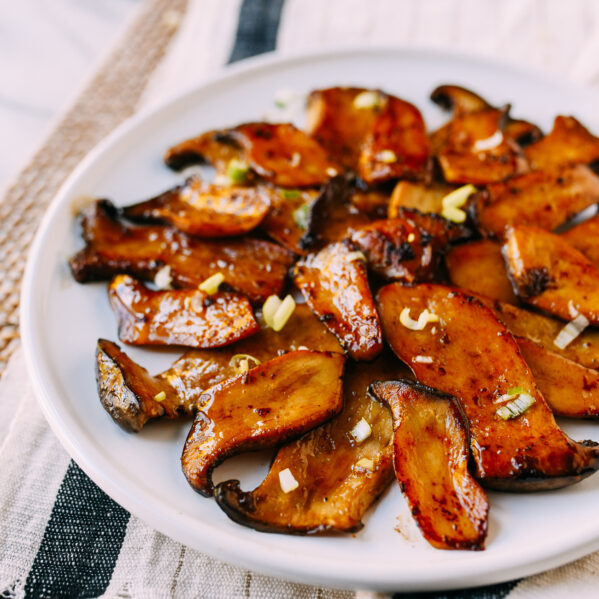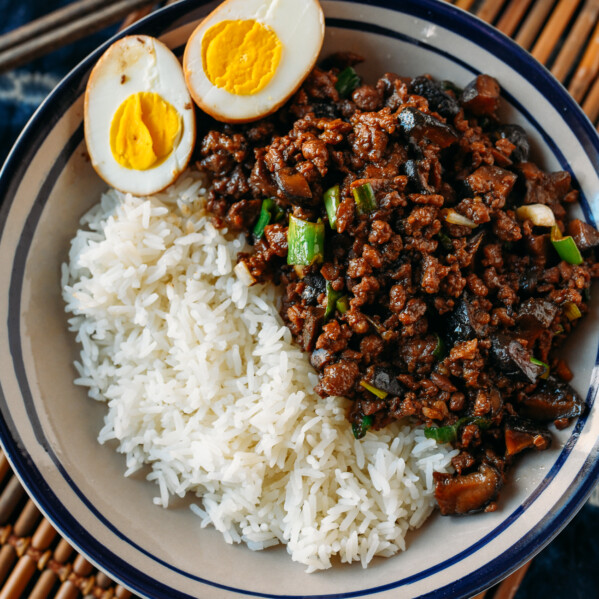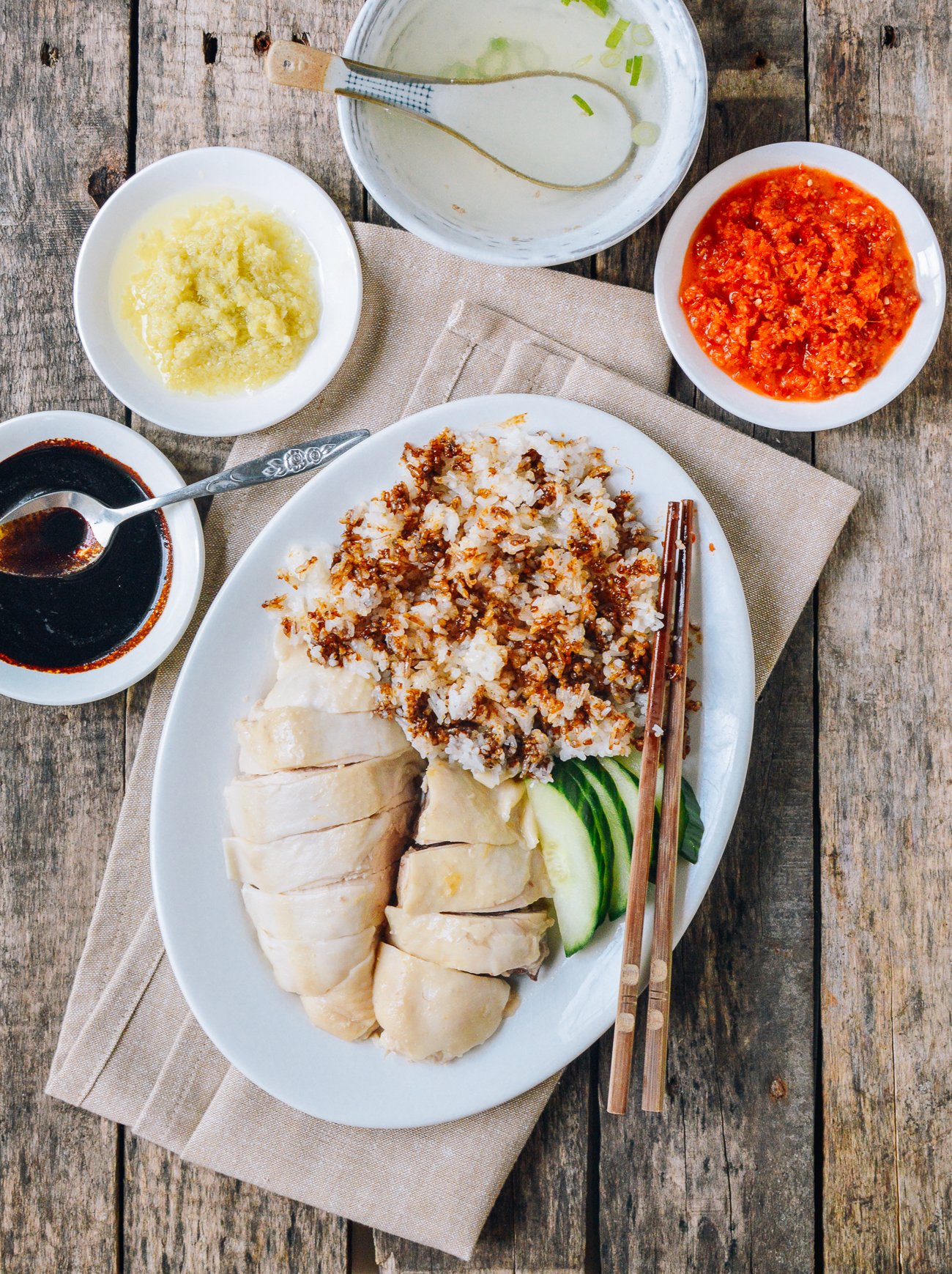
Hainan Chicken Rice is a classic dish beloved by people in Singapore and all over Asia. Served room temperature, the chicken is incredibly silky. But the rice is really the star—cooked in the broth from poaching the chicken, served with a trio of condiments.
This recipe takes some work, but it’s worth it!
Note:
This recipe was originally published on August 8, 2015. We have since re-tested and updated it with a video, clearer photos and instructions, metric measurements, and nutrition info. We have made some minor modifications to the recipe instructions to make them clearer. Enjoy!
The Origins of Hainan Chicken Rice
Hainan Chicken Rice (海南鸡) originated––perhaps unsurprisingly––amongst chefs from Hainan, China, a tropical island located at the southern tip of the country.
Hainan has become a top tourist destination in China, probably due at least in part to the abundance of delicious plates of Hainanese chicken rice, not to mention the tropical beaches.
Many say that the dish was actually invented by these Hainanese chefs in the country of Singapore, where it is the national dish.
Hainanese chicken rice has become a famous dish (thanks, Anthony Bourdain!), but it’s especially popular in South East Asian countries like Singapore, Malaysia and Thailand. There are large Chinese populations in these countries, and this dish crossed borders along with Chinese migrant workers.
Get the right chicken!
For best results, make this with a a buddhist-style whole chicken from a Chinese grocery store. Yes, that means head and feet on!

These chickens are a different breed than regular supermarket chickens, and have a much better texture. It will make a HUGE difference. Read more about it in our post on cooking whole chicken.
If you’re not near a Chinese market, the next best alternative is an organic or pasture-raised chicken. Bell & Evans air chilled chicken is also a good alternative.
Video: Watch Us Make It
What’s So Special About Poached Chicken & Rice?
While the chicken is undoubtedly a key component of the dish, I personally think the main event is the rice, which is cooked with chicken fat and chicken stock (from poaching the whole chicken).
Normally, we cook rice with plain water, so I can only imagine the reactions when people first taste this rice: eyes-popping and jaws dropping (to shovel in more of that rice, of course). It’s a luxury to cook rice using chicken soup, and the taste is better than plain white rice by a mile and a half.
As if the rice weren’t enough, the Hainan chicken is perfectly cooked, emerging from the stock pot (and then an ice bath) so the meat is at room temperature and perfectly moist and silky, with snappy skin.
And on top of all that, you get to douse the whole thing in as much sauce as you want. In this case, there are three sauces: a chili sauce, a ginger garlic sauce, and a sweet dark black soy sauce.

Mixing everything all together is so incredibly satisfying, you’ll quickly see why this dish is so beloved in Singapore, where good food is everywhere!
This Hainanese chicken rice recipe takes some concentration and a little elbow grease, but the results are well worth the effort. When you sit down to your plate of chicken rice and start spooning on all those sauces, you’ll feel transported to a hawker center in Singapore!

Hainan Chicken Rice: Recipe Instructions
For the Hainan chicken:
Wash the chicken clean and remember to set aside the piece of chicken fat from the back of the cavity.

Transfer the chicken to a plate and pat dry with a paper towel. Lightly rub the chicken with the salt. This will give the chicken skin a nice sheen. Set it aside.
Bring the water, along with the ginger and scallions, to a boil in a large stockpot.

Carefully lower the chicken into the boiling water, positioning the chicken breast-side up.

Now is a good time to adjust the water level so the chicken breast just pokes above the water (so you aren’t left with dry white meat).
Wait for the water to come to a boil again. Once it does, carefully lift the chicken out of the water to pour out the colder water that is trapped in the cavity. Carefully lower the chicken back into the pot.

(For more detail on this, check out our Cantonese poached chicken recipe.)
Bring the water to a boil again. When it is JUST starting to boil, turn the heat down. Keep it at barely a simmer. There should be very little movement in the water, but it also shouldn’t be still. Cover the pot, and keep the heat around the lowest setting so the liquid continues to simmer slowly.
Cook for about 30-35 minutes, roughly 10-11 minutes per pound. Depending on the size of your chicken, it may take more or less time to cook it through. (If you have a chicken larger than 3 1/2 pounds, it will take more like 40-50 minutes to cook.) You can check to make sure the water is bubbling slowly/gently and not boiling too vigorously, but try to avoid uncovering the pot while it’s cooking.
To check if the chicken is done, stick a toothpick into the thickest part of the thigh until it touches the bone. If the juices run clear, it’s cooked through.

The chicken in this Hainanese chicken rice recipe is very similar, if not identical, to how you cook Cantonese poached chicken.
When your timer for the chicken is almost up, prepare a large ice bath. Once the chicken is cooked, carefully lift the chicken out of the pot, drain the water from the cavity and lower it into the ice bath. Take care not to break the skin.
After 15 minutes in the ice bath, drain completely and cover with clear plastic until ready to cut and serve. The ice bath stops the cooking process, locks in the juices, and gives the chicken skin better texture. Trust us.


TIp for a more concentrated chicken stock
If you like, you can leave the pot of chicken poaching liquid simmering uncovered (so it reduces and concentrates flavor for cooking the rice in the next step.
To cook the rice:
While the chicken is cooling, make the rice. Before we explain further, 3 cups of rice is a good amount usually for 5-6 people, however this rice is soooo delicious that you may want to throw an extra cup in because it will absolutely get gobbled. Heat a wok or large skillet over medium heat. Add the chicken fat, along with 1 teaspoon of oil, and cook for 1-2 minutes, or until you have about 1 tablespoon of rendered fat.

Stir in the minced garlic and fry briefly, making sure it doesn’t burn.

Add the uncooked jasmine rice. Stir continuously for about two minutes.
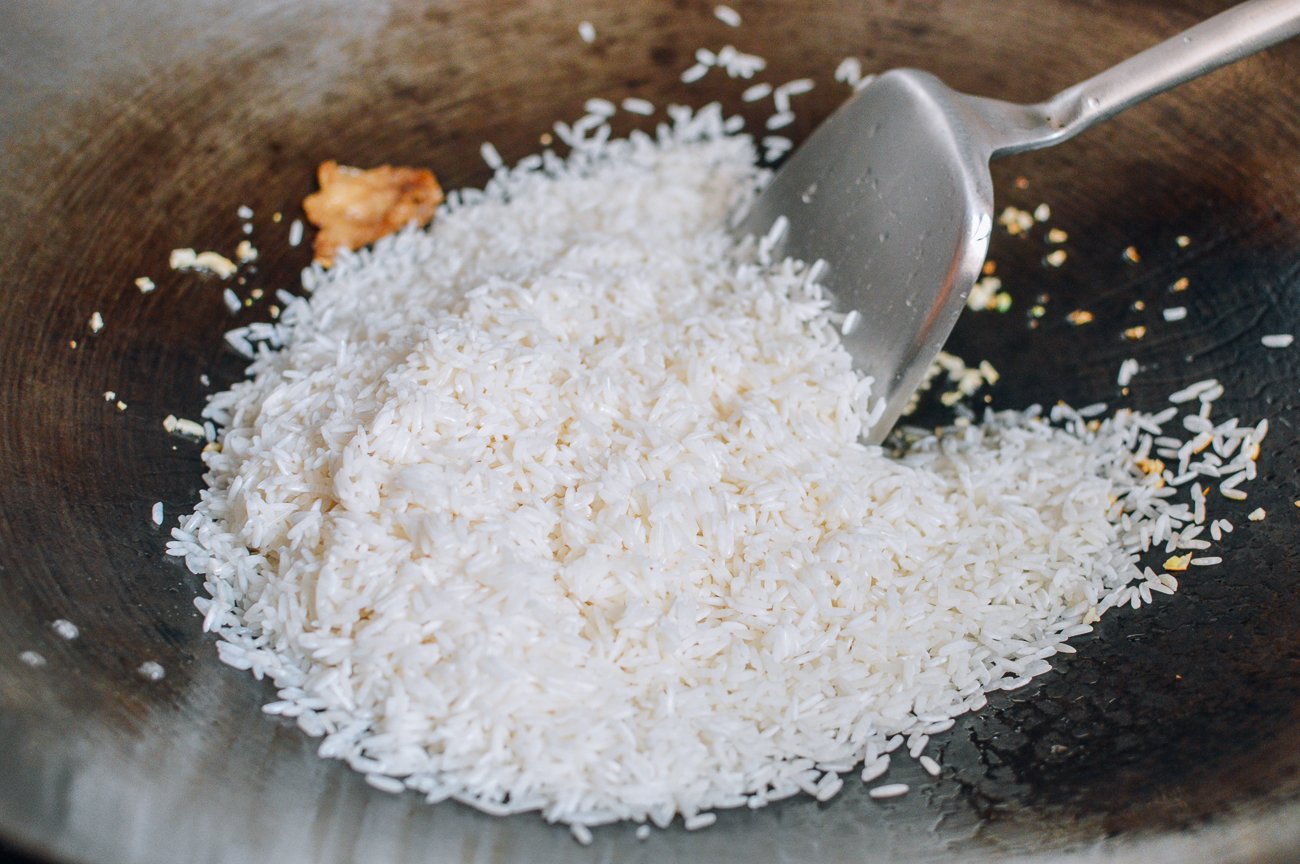
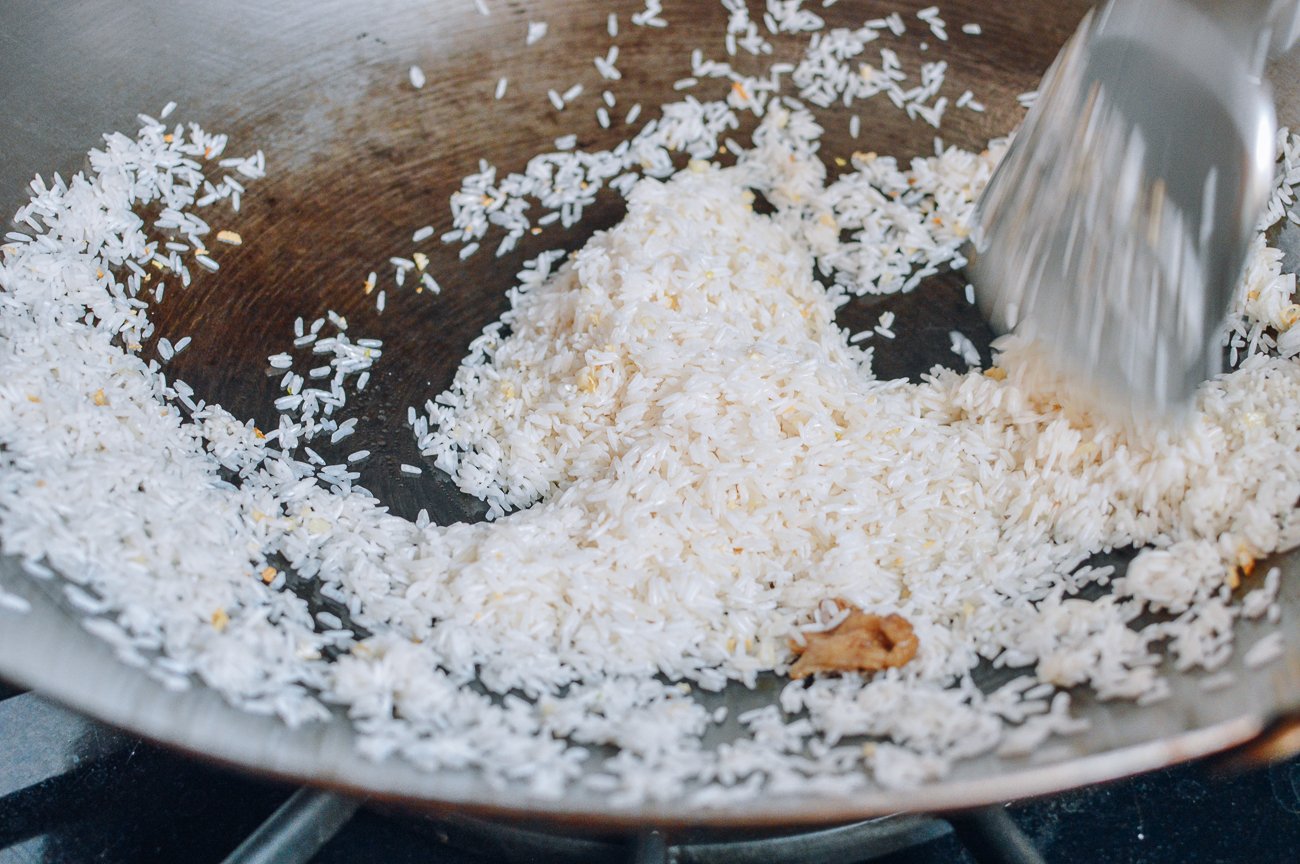
Turn off the heat. Scoop the rice into your rice cooker (leave the hunk of chicken fat behind or add it to the rice—your choice).

Add the stock from poaching the chicken (instead of the usual water) until it reaches the ‘4’ line (3 US cups = 4 rice cooker cups). Stir in the salt. Close the lid and press START.


Rice Cooker cups vs. US cups
For those of you using a rice cooker, 1 standard rice cooker cup is equal to a U.S. 3/4 measuring cup. Whenever we call for “cups” of raw rice in a recipe, we mean U.S. cups, not rice cooker cups.
3 U.S. cups is 4 rice cooker cups, which is why, after transferring the rice into the cooker, you add water up to the 4 cup line inside the rice cooker pot.
If you don’t have a rice cooker, transfer the toasted rice to a medium/large pot. Add 4 cups of chicken stock and the salt, giving it a quick stir. Soak the rice for 20 minutes. Then cover the pot and bring to a boil. Once it boils, immediately turn down the heat to the lowest setting. Let the rice simmer and cook (covered) for 15 minutes, until the liquid has absorbed into the rice, and it is tender.
Just be sure to keep an eye on it! Burnt rice is no fun.
While the rice is cooking, let’s prepare the three signature dipping sauces. You can also start preparing these sauces while the poached chicken is cooking in the pot.
Hainan Chicken Sauce 1: Ginger-Garlic Sauce
- 4-inch piece of ginger, roughly chopped
- 1 clove garlic
- 3 tablespoons neutral oil (such as vegetable, canola, or avocado oil)
- 1 pinch of salt
Grind the ginger and garlic in a food processor until finely minced. Heat the oil in a small pot or saucepan.


Gently fry the ginger and garlic until aromatic and just lightly caramelized. You want to cook it just until it no longer has that spicy raw flavor of uncooked ginger and garlic.

Add salt to taste, and transfer to a sauce dish.
Fun Fact!
If the ginger garlic sauce becomes thick like a paste, you have cooked it too long. But don’t worry! Simply remove from the heat and stir in some of the hot chicken cooking water until you get back to a sauce consistency.
Hainan Chicken Sauce 2: Sweet Dark Soy Sauce
- 1/4 cup water
- 1.25 ounces rock sugar (about 2 sizable chunks, or substitute 2.5 tbsp granulated sugar)
- 1/4 cup dark soy sauce
Heat the water and sugar in a small saucepan over medium heat. Stir constantly until the sugar dissolves and the liquid thickens into a syrup.
Add the dark soy sauce, stirring to combine. Transfer to a sauce dish.


Hainan Chicken Sauce 3: Chili Sauce
- 3 fresh red chilies (choose a chili with medium spice level; we used holland chilies)
- 1.5-inch piece ginger
- 2 cloves garlic
- 1/4 teaspoon sesame oil
- 1/2 teaspoon salt
- 1/4 teaspoon sugar
- 1 tablespoon fresh lime juice (1 tbsp/15ml = the juice of 1/2 lime)
- 1/2 teaspoon rice vinegar (or white vinegar)
- 2 tablespoons broth from boiling the chicken (or until a saucy consistency is achieved)
Grind the chilies, ginger, and garlic in a food processor until finely chopped. You will probably have to scrape down the sides of the food processor 1-2 times to get an even texture. Add the sesame oil, salt, sugar, lime juice, and vinegar to the food processor. Pulse 2-3 times to combine.



Transfer to a small bowl and add chicken broth (the chicken cooking liquid) 1 tablespoon at a time until you get a saucy consistency. This is really about your preference too; if you like a thicker paste, add less broth. The broth also helps the sauce come together and adds additional chicken flavor!
Tip!
If you don’t have a food processor, or would rather have a more pulverized consistency, you can make this sauce in a mortar and pestle.
To serve your chicken, carve it up, serve it with your rice and three sauces. You can also serve some of the heated chicken broth (be sure to season generously with salt. A pinch of MSG doesn’t hurt either) with the meal.

See our Post on How to Carve a Whole Chicken, Chinese-Style
For a full tutorial on how to carve your chicken for serving, see our post on how to cut a whole chicken Chinese-style.
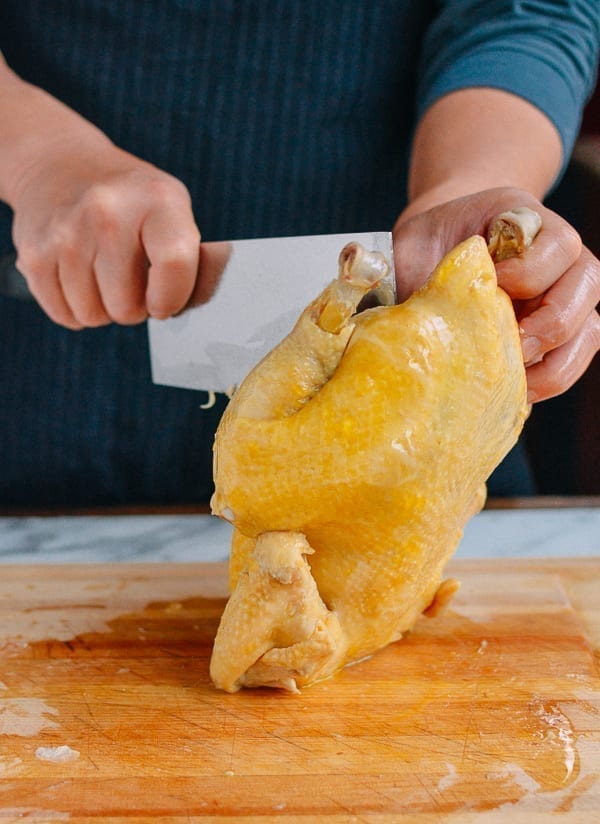

I personally like to pour the dark soy sauce and ginger mixture all over my rice, and then eat each bite of chicken with a bit of the flavored rice and chili sauce, but everyone has their preference in terms of how they like to enjoy their Hainanese Chicken rice meal. Make it your own!
There you have it. A perfect Hainanese chicken rice that would impress anyone, even a Singaporean!

Looking for more authentic recipes? Subscribe to our email list and be sure to follow us on Pinterest, Facebook, Instagram, and Youtube!
Recipe
Hainanese Chicken Rice
Ingredients
For the Chicken:
For the Rice:
- 2 ounces chicken fat (taken from the cavity of the chicken)
- 1 teaspoon neutral oil (such as vegetable, canola, or avocado oil)
- 4 cloves garlic (minced)
- 3 cups uncooked white rice (preferably jasmine rice, washed and drained)
- Chicken stock (from cooking the chicken)
- 2 teaspoons salt
For the Ginger-Garlic Sauce:
For the Sweet Dark Soy Sauce:
- 1/4 cup water
- 1.25 ounce rock sugar (2 sizable chunks, or substitute 2.5 tbsp granulated sugar)
- 1/4 cup dark soy sauce
For the Chili Sauce:
- 3 fresh red chilies (choose a chili with medium spice level; we used holland chilies)
- 1.5-inch piece ginger
- 2 cloves garlic
- 1/4 teaspoon sesame oil
- 1/2 teaspoon salt
- 1/4 teaspoon sugar
- 1 tablespoon fresh lime juice (1 tbsp/15ml = the juice of 1/2 lime)
- 1/2 teaspoon rice vinegar (or white vinegar)
- 2 tablespoons broth from boiling the chicken (or until a saucy consistency is achieved)
Instructions
To Make the Chicken:
- Wash the chicken clean and remember to set aside the piece of chicken fat from the cavity. Transfer the chicken to a plate and pat dry with a paper towel. Lightly rub the chicken with the salt. This will give the chicken skin a nice sheen. Set it aside.
- Bring the water, along with the ginger and scallions, to a boil in a large stockpot. Carefully lower the chicken into the boiling water, positioning the chicken breast-side up. Now is a good time to adjust the water level so the chicken breast just pokes above the water (so you aren’t left with dry white meat).
- Wait for the water to come back up to a boil. Once it does, carefully lift the chicken out of the water to pour out the colder water that is trapped in the cavity. Carefully lower the chicken back into the pot. Bring the water to a boil again. When it is JUST starting to boil again, turn the heat down. Keep it at barely a simmer. There should be very little movement in the water, but it also shouldn’t be still. Cover the pot, and keep the heat around the lowest setting so the liquid continues to simmer slowly.
- Cook for about 30-35 minutes, roughly 10-11 minutes per pound. Depending on the size of your chicken, it may take more or less time to cook it through. (If you have a chicken larger than 3 1/2 pounds, it will take more like 40-50 minutes to cook.) You can check to make sure the water is bubbling slowly/gently and not boiling too vigorously, but try to avoid uncovering the pot during cooking.
- When the timer (for the chicken) is almost up, prepare a large ice bath. To check if the chicken is done, stick a toothpick into the thickest part of the thigh until it touches the bone; if the juices run clear, it’s cooked through. Carefully lift the chicken out of the pot, drain the water from the cavity and lower it into the ice bath. Take care not to break the skin. After 15 minutes in the ice bath, the chicken should be cooled completely, drain and cover with clear plastic until ready to cut and serve.
- If you like, you can leave the pot of chicken poaching liquid simmering uncovered (so it reduces and concentrates flavor for cooking the rice in the next step.
To make the rice:
- While the chicken is cooling, make the rice. Heat a wok or large skillet over medium heat. Add the chicken fat, along with 1/2 teaspoon of oil, and cook for 1-2 minutes, or until you have about 1 tablespoon of rendered fat. Stir in the minced garlic and fry briefly, making sure it doesn’t burn. Add the uncooked rice. Stir continuously for about two minutes.
- Turn off the heat. Scoop the rice into your rice cooker (leave the hunk of chicken fat behind or add it to the rice—your choice) and add the stock from poaching the chicken (instead of the usual water) until it reaches the '4' line (3 US cups = 4 rice cooker cups). Stir in the salt. Close the lid and press START.
- If you don’t have a rice cooker, transfer the toasted rice to a medium/large pot. Add 4 cups of chicken stock and the salt, giving it a quick stir. Soak the rice for 20 minutes. Then cover the pot and bring to a boil. Once it boils, immediately turn down the heat to the lowest setting. Let the rice simmer and cook (covered) for 15 minutes, until the liquid has absorbed into the rice, and it is tender.
To Make the Ginger Garlic Sauce:
- Grind the ginger and garlic in a food processor until finely minced. Heat the oil in a small pot or saucepan. Gently fry the ginger and garlic until aromatic and just lightly caramelized. You want it to be just cooked so that it no longer has that spicy raw flavor of uncooked ginger and garlic. Add salt to taste and transfer to a sauce dish.
To Make the Sweet Dark Soy Sauce:
- Heat the water and sugar in a small saucepan over medium heat. Stir constantly until the sugar dissolves and the liquid thickens into a simple syrup. Add the dark soy sauce, stirring to combine. Transfer to a sauce dish.
To Make the Chili Sauce:
- Grind the chilies, ginger, and garlic in a food processor until finely chopped. You will probably have to scrape down the sides of the food processor 1-2 times to ensure everything is ground up evenly. Add the sesame oil, salt, sugar, lime juice, and vinegar to the food processor. Pulse 2-3 times to combine. You can also do this in a mortar and pestle.
- Transfer to a small bowl and add chicken broth (what you used to boil the chicken) 1 tablespoon at a time until a saucy consistency is achieved. This is really about your preference too; if you like a thicker paste, add less broth.





